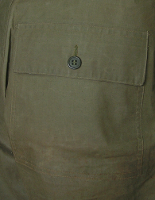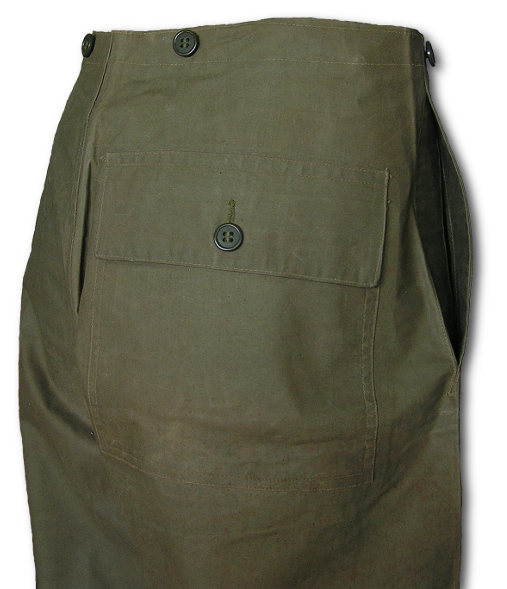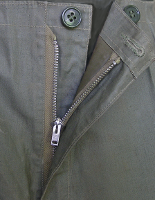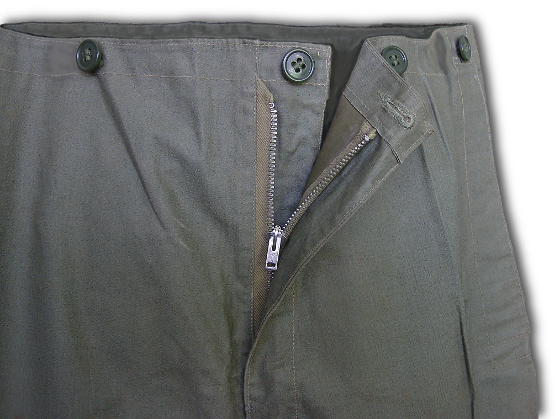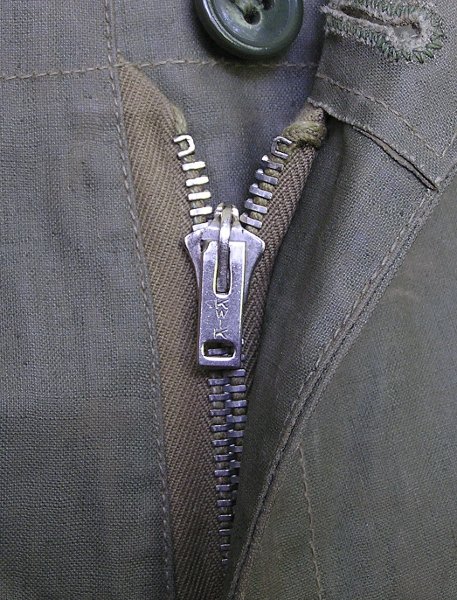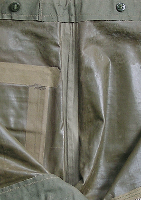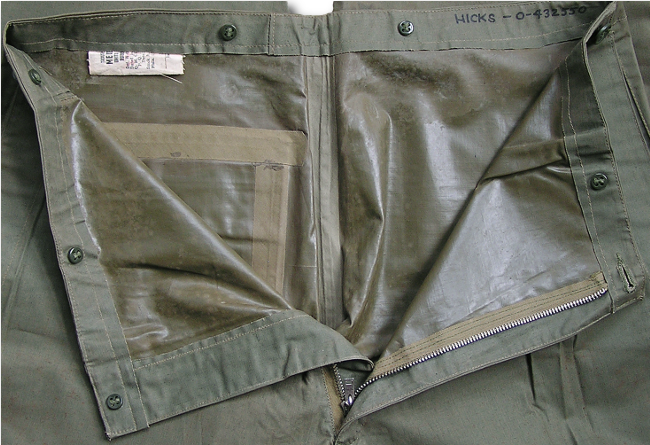U.S. Army Men's Trousers
Rain Trousers



Specification PQD 151 Dated 18 March 1942
Stock No. 72-T-1010 - 72-T-1025
Primary Issue: Mandatory allowance for enlisted men, officers, and warrant officers in organizations such as Rescue Boat Squadrons, Mine Planter Services, Coast Artillery, Marine Transportation, Amphibious Truck & Armor, & Port Repair teams. Discretionary issue for all other personnel.
| Key Visual ID | Primary Materials | Fasteners | Color | Labeling |
| Trouser styling, right rear patch pocket, and zip fly front. | Synthetic resin coated material. | There were 8 buttons: 1 x front fly, 6 x suspender buttons, and 1 x rear pocket flap hold down. There was a zipper closure at the front fly. | Olive Drab Shade 7. | The quartermaster label was sewn into the waistband seam on the inside right rear of the trousers. Sizing was indicated on the Quartermaster label. |
| Treatments | Approx. Contract Run | Preceded By | Replaced By | Companion Garments |
| Synthetic resin coating developed from limestone, coke, and salt by B.F. Goodrich Co. The treatment was commercially known as Koroseal and was used to waterproof and stain proof materials used to manufacture tablecloths, rain wear, shower curtains, etc. | Contracts have only been noted for July 29 & 31, 1942 but manufacturing likely spans a greater date range. | Rain Trousers, specification PQD 51 dated 29 April 1941. | Wet Weather Trousers, specification PQD 288A dated 22 June 1943. | Rain Jacket and Rain Hat, Spec. PQD 151. Trousers Suspenders. |
(hover for expanded view)
These trousers were part of a three piece ensemble that included a jacket and hat. All three articles were encompassed within the specification PQD 151 and were issued together as an outfit. The rain jacket, trouser, and hat combo took advantage of a new synthetic resin compound in its construction, whereas previous rain gear utilized a rubber coated fabric. Under development for some time, the new material was adopted just in time to help offset critical shortages of rubber caused by severe war time demands. There was never complete satisfaction with the synthetic compound, so there was ongoing debate as to how the substance should be applied to material and what garment construction methods should be employed to maximize its effectiveness. As a result, trial garments were produced using several different methods. Fabric was produced in which the resin coating was applied to one or both sides. Construction occurred by stitching or gluing seams together and utilizing rivets in various locations. In the end, manufacturing difficulties, material procurement delays, and conservation pressures mostly limited the application of the resin coating to one side of the material. After satisfactory testing, the Quartermaster General deemed the one sided resin application acceptable when garments were constructed with the coated side facing toward the body and the textured fabric side faced away from the body. As a result, the majority synthetic coated rain gear was produced in this manner from mid-1942 through the end of the war. It is unknown how many different material types or construction methods were used in the manufacture of these trousers. The example shown above was constructed using material coated on one side, with the untreated fabric side facing outward. Seams were double stitched with strapping applied to the reverse. Strapping involved gluing a fabric strip over the back side of the seam to help waterproof the garment. All edge finishing is stitched. Several new features were incorporated in the specification 151 rain trouser design to improve wearability over the previous type. | A zipper opening was utilized that eased the process of taking the trousers on and off. While the older rain trousers were held up by a simple waist drawstring, suspender buttons were introduced on the specification 151 model to provide a more secure suspension system. Rounding out the new features was the addition of reach through slits at each hip, which allowed access to clothing underneath. In contrast to other rain trouser designs, the specification 151 trouser did not have any gathering tabs or strings at the ankle. Sizing was a simple system that included small, medium, large, and x-large, with the cut being oversized to allow for adequate fitting over other clothing. Multiple piece rain suits were numerous in the war years. The Specification 151 suit was preceded by a rubberized parka-style set that included a hooded, zip neck, pull-over top, and a simple set of drawstring trousers. When the Army replaced the Specification 151 rain suit, once again, a hooded, pull-over, parka-style design was utilized. This time, though, it featured a buckle neck opening, overall style trousers, and resin coated material. The specification 151 rain suit was similar in appearance to the U.S. Navy foul weather suit of the same time period, except for its color. Respectively, the Army and Navy typically followed similar patterns in their wet weather clothing development. Wet weather suit combos were generally issued to troops whose primary job functions were likely to expose them to wet and/or foul weather conditions. The multiple piece construction was essential in allowing freedom of movement and protection from wet conditions while performing essential job functions; an important distinction when issuing rain suits opposed to the standard raincoat. Port workers, amphibious units, marine transportation units, and the like would have been issued these types of multi-piece rain suits. |
